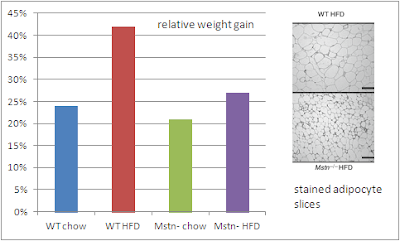 |
| Image 1: Belgian Blue cattle are "naturally" myostatin negative. These beasts are 100% muscle 0% fat and though your usual clenbuterol fattened meatstock cannot compete, the heavily abused beta-2 agonist could infact work its muscle building, fat burning magic via very similar mechanisms. |
You have probably heard at least one of the dozens of reports on
clenbuterol in pork, chicken, beef and lately sheep meat from China, haven't you? I mean,
that kind of meat, innocent Tour de France competitors consume and end up with a positive doping test ;-) "Clenbuterol?", some of you may now ask themselves: "Isn't that the illegal
fat burner bodybuilders use to get totally shredded in the last weeks of their contest prep?" Well, you are right, but "
lean meat powder" (
CRJ. 2011), as our Chinese friends call it, has another, less known and hitherto not completely understood quality:
Clenbuterol builds muscle! And while we did already know that these effects are mediated via its beta-2-adrenergic activity (
Hinkle. 2002), the underlying mechanism of how "stress" (remember the main beta-2 agonist in the human body is noradrenaline) can induce muscle growth and prevent atrophy, have hitherto been obscure. With the recent publication of a studies on the metabolic (not myogenic, i.e. muscle-building) effects of myostatin and its inhibition by beta-2 agonists this may yet change...
The two studies, on which my argumentation will be based were published in the diabetes journal
Diabetologia (
Zhang. 2011) and the journal of the Endocrine Society,
Endocrinology (
Pearen. 2011)
. Zhang and his colleagues from Singapore have studied the
effects of my all-time favorite high-fat diet (HFD; 60% of the calories from fat, but by no means "low carb") on myostatin-null mice, mice fed with the type IIB receptor, sActRIIB, which binds and deactivates myostatin, and wild type mice - and I must say, their findings are quite exciting.
 |
| Figure 1: Relative weight gain (compared to baseline, left) and haematoxylin and eosin stained adipocytes from WAT (right) of wild-type and Mstn − /− mice after 12 weeks of chow diet and HFD treatment (adapted from Zhang. 2011). |
Deletion or deactivation of myostatin, the TGF beta protein you probably associate with
over-muscled, but clumsy and a few exceptions, such as the Belgian Blues in image 1, aside, usually
not particularly lean "mutants", did not only
prevent the additional +18% weight gain in the HFD group (despite almost identical nutrient intake, cf. figure 1), it also modulated the triglyceride content (-250%!) and size of the mouse adipocytes (cf. figure ,1 small images).
 |
| Figure 2: Relative increase in fatty ocid oxidation (compared to baseline, left) and decrease in non-esterified fatty acids of wild-type and Mstn − /− mice after 12 weeks of chow diet and HFD treatment (adapted from Zhang. 2011). |
And if you look at the increase in liver and white adipose tissue (WAT) fatty acid oxidation, the consequent decrease in non-esterified fatty acids (NEFA) and the profound increase in body temperature in the myostatin knock-out mice (cf. figure 2), you must concede that this data could as well have come from a study on one of the beta-2-agonist such as the short acting
salbutamol, levosalbutamol & metaproterenol and the long-acting beta-2 adrenergic agonists
clenbuterol, salmeterol, formoterol & bambuterol. Zhang et al. emphasize that these fat-burning effects, of which further analyses revealed that they are
mediated largely by "enhanced PPAR pathway signalling" and increased expression of mitochondrial uncoupling proteins (>4x PPAR-a; >12x UCP1, >6x UCP2 and >4x UCP3 in epididymal white adipose tissue of HFD myostatin-negative mice), go way beyond what we would see as "a secondary effect of the increased muscle mass observed in the myostatin-negative mice" and have a certain similarity to what we would see in brown (BAT), not white adipose tissue - mystatin inhibition, as the scientists phrase it in the title of their paper thusly "promotes a brown adipose tissue phenotype", or, put more simply, it makes the fat-
storing white adipose tissue behave as if it actually was its fat-
burning brown cousin ;-)
Clenbuterol <> NOR-1 <> Myostatin |
| Image 2: Alberto Contador knows about the "advantages" of Chinese fatstock (BBC. 2011) |
To understand how all this relates to the Pearen study (
Pearen. 2011), we have to look at a tangent of the study, which investigated the role of the orphan nuclear receptor NOR-1 in the beta-adrenergic cascade. As it turned out, NOR-1 is expressed in skeletal muscle in response to exposure to beta-2-agonists and does not only modulate fatty acid oxidation (as we would have expected), but also dose-dependently repressed the myostatin promoter. Put simply,
beta-2-activation induced NOR-1 activity releases the "hypertrophy break" and may thusly explain the well-known muscle building "side-effects" of
clenbuterol,
albuterol and all the other Chinese "
lean meat powders" ;-)
More than a word of caution! Now, this would not the SuppVersity, if I did not conclude this post with a word of caution:
Neither the (ab-)use of clenbuterol or ephedrine (which is a weaker beta-2 agonist,
Yamahara. 1985)
nor the myostatin-"binder" sActRIIB, which, by the way, rendered the wild-type mice similar resistant to diet-induced obesity as their genetically engineered myostatin-negative peers,
constitute safe ways to get the muscular and fat-free physique of your dreams. Remember that before you throw away your grass-fed beef and begin importing Chinese fatstock ;-)



